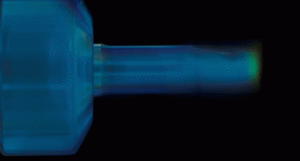- Blog
- Future Concepts
- Process monitoring of minimum quantity lubrication
Process reliability above all else
We see the general efforts towards digitisation, besides the realisation of new business models, as the desire for more process reliability in production. In our opinion this applies especially to the metal-processing industry. Our basic assumption is that a good and uniform process also yields a good and uniform quality. At Unilube we therefore focus on the process itself and its stability. Process monitoring, on the other hand, is above all a cost factor, at times an unavoidable one, and should only be employed when there is no other option. Nevertheless, we have tested various things in the field of process monitoring – such as sensor-monitored dosing.
Sensor-monitored dosing amount
In an experimental setup, a laser sensor was mounted that monitored the position of the piston rod (see Figure 1) or its travel path. With the signal received, it was possible to precisely record both the dosing amount as well as the number of dosing cycles. The results were plausible and very informative. As a sensor with a compact design was selected, this sensor technology could also easily be used on a multi-nozzle system. As long as there is a customer requirement, there is nothing in the way of implementing it from a technical view. A possible cost-effective alternative would be to monitor the pressure peaks: although this would not allow for the exact dosing amount but the number of cycles triggered to be monitored. With this solution, however, you are very close to a control signal of the machine having almost the same informative value.
 Figure 1: Experimental setup
Figure 1: Experimental setup
Business sense and data nonsense:
The big question of costs/benefits is very fundamental when it comes to Industry 4.0. The costs can be clearly formulated in each case, but it gets much more difficult when it comes to the expected benefit and the question as to which data must be actually collected, processed or even saved. If we give process reliability the highest priority, our advice regarding minimum quantity lubrication is as follows: “Process monitoring should be implemented directly via the machine’s control signals. Monitoring the level of the lubricant reservoir is also a must. But the most important element of all for the highest process reliability is the consistent application of tools with internal cooling (IKZ).” Maximum process reliability is thereby achieved and the expectations of Industry 4.0 are also met – not to mention the improvement in cost-effectiveness that is achieved in the area of tool service life and processing time thanks to quasi-dry machining. In this way, the customer also gets a genuine, quantifiable added value.
 Figure 2: Measurement signals with a total of 11 cycles with different delivery volume
Figure 2: Measurement signals with a total of 11 cycles with different delivery volume
Did you like this blog article? Subscribe to our newsletter and we will provide you with the latest specialist knowledge all round quasi-dry machining every month.



